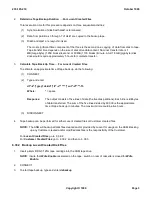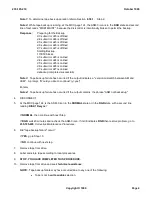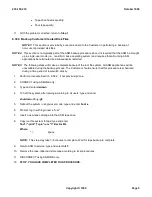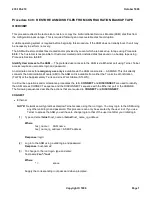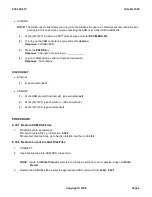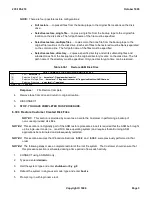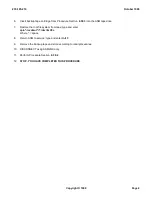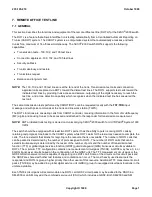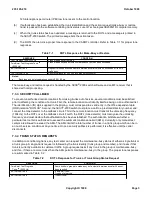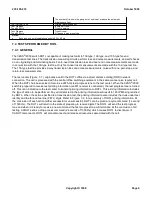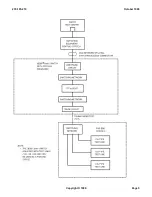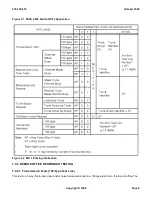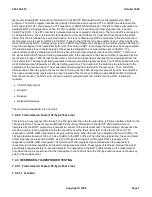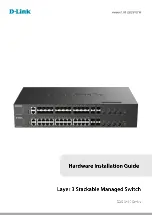
7. REMOTE OFFICE TEST LINE
7.1 GENERAL
This section describes the functions and equipment of the remote office test line (ROTL) for the
5ESS
®
-2000 switch.
The ROTL is a feature that allows interoffice trunk testing automatically from a Centralized Automatic Reporting on
Trunks (CAROT) system. The CAROT system is a computerized system that automatically accesses and tests
trunks for a maximum of 14 offices simultaneously. The
5ESS
®
-2000 switch ROTL supports the following
capabilities:
Transmission tests
100, 102, and 105 test lines
Connection appraisal
100, 102, and 105 test lines
Security callback
Trunk make-busy and restore
Trunk status request
Balance and long-term test.
NOTE:
The 100, 102, and 105 test lines are at the far end of the trunk. Transmission test calls and connection
appraisal calls are placed via ROTL toward the distant test lines. The ROTL supports test calls toward the
indicated test lines by providing trunk access and seizure, outpulsing of the digits necessary to reach the
test line, and a tone detection capability which recognizes when the indicated test line has answered the
test call.
The same transmission tests performed by CAROT/ROTL can be requested locally with the
TST:TRK
input
message and with poke commands at the trunk and line work station (TLWS).
The ROTL functions are answering calls from CAROT controller, receiving information in the form of multifrequency
(MF) digits, and causing trunks to be accessed and attached to the responder for transmission measurement.
NOTE:
ROTL-initiated trunk testing is denied on trunks carrying
5ESS
®
-2000 switch for
AUTOPLEX
®
System 1000
traffic.
The switch should be equipped with at least two ROTL ports. It has the ability to park incoming ROTL calls by
returning test progress tone back to the CAROT system while ROTL waits for the resources needed to complete the
calls. The tone detector that listens for recycling is the resource that is unavailable. The number of ROTL calls that
can be parked is determined by the number of ports assigned to ROTL. The number of ROTL calls that can be
served simultaneously is determined by the lesser of the number of ports and the number of transmission test
function (TTF) or global digital services function (GDSF) guard data guard (GDG) transceiver circuits available to
ROTL. The minimum TTF configuration contains one measurement circuit pack (TN304). A GDSF may have 0, 4, or
6 GDG transceiver circuits based on the configuration of the GDSF unit. The TTF measurement circuit pack or the
GDSF GDG transceiver circuit is capable of supporting one ROTL call. Some of the circuits on this circuit pack and
the GDSF are shared with other test features and contention can occur. The most heavily used resource is the
responder and ROTL is given a higher priority than other users of this resource. Additional TTF measurement circuit
packs (TN304) may be added in a global digital service unit (GDSU) group if unequipped circuit pack locations in the
unit are available.
Each TN304 circuit pack will accommodate one ROTL call. GDSF circuit packs may be added to the DSU3 in a
SM-2000 or an SM may add the combined service unit (CSU) which includes a GDSF. Both SM-2000 and SM
235-105-210
October 1999
Copyright © 1999
Page 1
Summary of Contents for 5ESS-2000
Page 96: ...235 105 210 October 1999 Copyright 1999 Page 2 ...
Page 184: ...235 105 210 October 1999 Copyright 1999 Page 3 ...
Page 300: ...13 STOP YOU HAVE COMPLETED THIS PROCEDURE 235 105 210 October 1999 Copyright 1999 Page 55 ...
Page 339: ...7 STOP YOU HAVE COMPLETED THIS PROCEDURE 235 105 210 October 1999 Copyright 1999 Page 13 ...
Page 342: ...235 105 210 October 1999 Copyright 1999 Page 2 ...
Page 359: ...235 105 210 October 1999 Copyright 1999 Page 5 ...
Page 609: ...2 STOP YOU HAVE COMPLETED THIS PROCEDURE 235 105 210 October 1999 Copyright 1999 Page 12 ...
Page 676: ...235 105 210 October 1999 Copyright 1999 Page 9 ...
Page 792: ...3 STOP YOU HAVE COMPLETED THIS PROCEDURE 235 105 210 October 1999 Copyright 1999 Page 9 ...
Page 799: ...Figure 11 36 3 1 Cleaning Points 235 105 210 October 1999 Copyright 1999 Page 7 ...
Page 801: ...235 105 210 October 1999 Copyright 1999 Page 9 ...
Page 839: ...2 STOP YOU HAVE COMPLETED THIS PROCEDURE 235 105 210 October 1999 Copyright 1999 Page 16 ...
Page 999: ...2 STOP YOU HAVE COMPLETED THIS PROCEDURE 235 105 210 October 1999 Copyright 1999 Page 13 ...
Page 1008: ...Figure 11 55 1 CTSNS DIP Switch Settings 235 105 210 October 1999 Copyright 1999 Page 2 ...
Page 1011: ...235 105 210 October 1999 Copyright 1999 Page 5 ...
Page 1053: ...235 105 210 October 1999 Copyright 1999 Page 15 ...
Page 1289: ...Figure 15 17 2 AMATPS Data Link 235 105 210 October 1999 Copyright 1999 Page 2 ...
Page 1292: ...235 105 210 October 1999 Copyright 1999 Page 5 ...
Page 1303: ...9 STOP YOU HAVE COMPLETED THIS PROCEDURE 235 105 210 October 1999 Copyright 1999 Page 2 ...
Page 1360: ...Figure 15 47 2 Typical SCANS III Link Diagram 235 105 210 October 1999 Copyright 1999 Page 2 ...
Page 1372: ...235 105 210 October 1999 Copyright 1999 Page 2 ...
Page 1374: ...235 105 210 October 1999 Copyright 1999 Page 4 ...
Page 1421: ...Table 1 1 O M Checklist 235 105 210 October 1999 Copyright 1999 Page 3 ...








